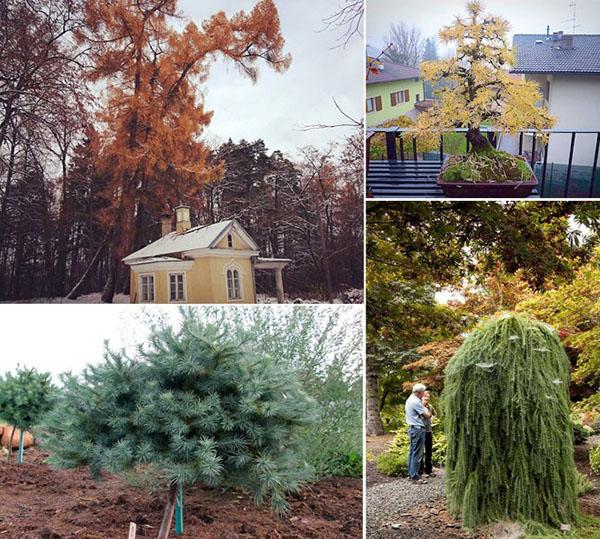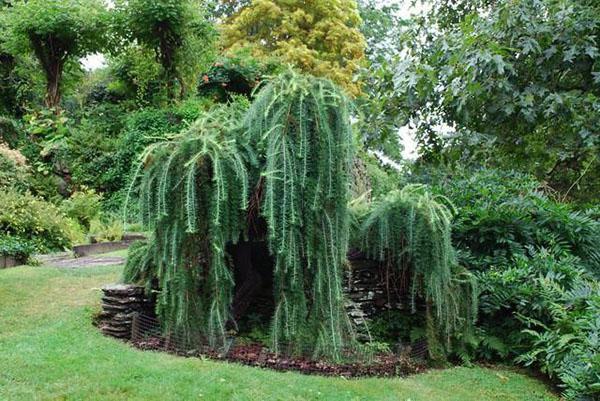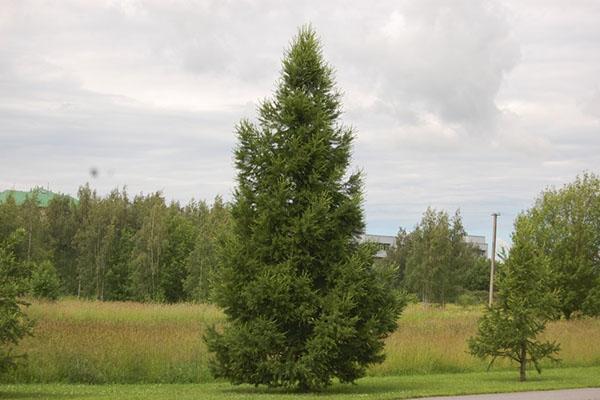Eye charm - larch: planting and care
 At all times, conifers have attracted the attention of people who were engaged in landscaping their backyard territory. Larch is especially impressive with its beauty, planting and caring for which brings true pleasure. This amazing plant is able to withstand extreme temperature changes. Not afraid of severe frosts and summer heat. Feels great even in the permafrost zone. That is why larch is actively used for the formation of exclusive landscape designs in the country and in urban landscaping.
At all times, conifers have attracted the attention of people who were engaged in landscaping their backyard territory. Larch is especially impressive with its beauty, planting and caring for which brings true pleasure. This amazing plant is able to withstand extreme temperature changes. Not afraid of severe frosts and summer heat. Feels great even in the permafrost zone. That is why larch is actively used for the formation of exclusive landscape designs in the country and in urban landscaping.
External features of a persistent Siberian beauty


In its natural environment, larch reaches about 50 m in height and is found in the territory:
- Siberia;
- Europe;
- North America;
- The Far East;
- Carpathians.
The maximum trunk diameter is up to 1 m. Young seedlings have a cone-shaped crown, while mature trees are often spread out. In early spring, the plant dresses in a green outfit made of juicy young needles. And in the fall, the larch falls off like seasonal trees. But before that, she shines with bright gold of magnificent decoration, which the great Russian poet may have described in verse.
And in the fall, the larch falls off like seasonal trees. But before that, she shines with bright gold of magnificent decoration, which the great Russian poet may have described in verse.
 An amazing feature of the plant is its soft needles. The maximum length of the needles is approximately 5 mm. In spring “flowers” appear on the tree, from which small ovoid cones are formed. They are painted bright green. Simple planting and caring for larch allows you to use it in the formation of a backyard landscape.
An amazing feature of the plant is its soft needles. The maximum length of the needles is approximately 5 mm. In spring “flowers” appear on the tree, from which small ovoid cones are formed. They are painted bright green. Simple planting and caring for larch allows you to use it in the formation of a backyard landscape.
Wood is widely used in construction. Essential oils, cellulose and valuable elements for medicines are also obtained from it. And bark, pine needles and resin in folk medicine.
An elegant decoration of the landscape - larch: planting and caring for the plant
 To create unique beauty at their summer cottage, designers advise using coniferous trees... They have a special appeal and charm throughout the season. Despite the fact that the Siberian beauty loses needles for the winter, she is truly a majestic tree.
To create unique beauty at their summer cottage, designers advise using coniferous trees... They have a special appeal and charm throughout the season. Despite the fact that the Siberian beauty loses needles for the winter, she is truly a majestic tree.
Since the tree actively absorbs harmful gases, it is advisable to grow it next to a gazebo for relaxation. It will provide the area with clean air.
Consider the secrets of the care and planting of larch in the Moscow region, since it is very popular here. They consist in the following main aspects:
- landing time;
- the nature of the soil;
- lighting;
- humidity;
- pruning.
 Fulfilling these simple requirements consistently, an amazing coniferous plant with soft needles will appear near the house. Unfortunately, some believe that the tree is of little use. Therefore, a controversial question arises: is it worth growing larch in the country? Pros and cons - different opinions, but it is better to make a decision individually, after a close acquaintance with the culture.
Fulfilling these simple requirements consistently, an amazing coniferous plant with soft needles will appear near the house. Unfortunately, some believe that the tree is of little use. Therefore, a controversial question arises: is it worth growing larch in the country? Pros and cons - different opinions, but it is better to make a decision individually, after a close acquaintance with the culture.
Planting timing
 First of all, you need to find the perfect time for planting. The best option for performing the procedure is spring before the needles appear, or mid-autumn, when the first falling of the needles began. During this period, the soil contains a small number of microorganisms that can disrupt the root system of larch. Its main feature is mycorrhiza, which lies in the natural symbiosis of roots with fungi. As a result, the tree successfully assimilates minerals and other nutrients from the soil. A plant is planted along with an earthen clod, regardless of its age.
First of all, you need to find the perfect time for planting. The best option for performing the procedure is spring before the needles appear, or mid-autumn, when the first falling of the needles began. During this period, the soil contains a small number of microorganisms that can disrupt the root system of larch. Its main feature is mycorrhiza, which lies in the natural symbiosis of roots with fungi. As a result, the tree successfully assimilates minerals and other nutrients from the soil. A plant is planted along with an earthen clod, regardless of its age.
When planting larch on a new site, add a little soil from under old pines, fir or spruce to the soil.
Suitable substrate

The unpretentious northern beauty grows wonderfully on various types of soil:
- acidic;
- neutral;
- alkaline.
 An example of this is the natural environment in which larch occurs: mountain slopes and wetlands. Despite this, it is important to understand that bred varieties are more vulnerable to growing conditions than natural varieties. Planting larch in autumn or spring is carried out in the usual way. For this, a wide hole is dug, which is 2 times the rhizome of the culture. Then the soil is mixed with peat and humus... Clay soil is diluted with coarse river sand. The bottom of the pit is covered with the prepared substrate, the seedling is laid and covered with the remaining soil. The upper ball is carefully tamped and watered with clean water.
An example of this is the natural environment in which larch occurs: mountain slopes and wetlands. Despite this, it is important to understand that bred varieties are more vulnerable to growing conditions than natural varieties. Planting larch in autumn or spring is carried out in the usual way. For this, a wide hole is dug, which is 2 times the rhizome of the culture. Then the soil is mixed with peat and humus... Clay soil is diluted with coarse river sand. The bottom of the pit is covered with the prepared substrate, the seedling is laid and covered with the remaining soil. The upper ball is carefully tamped and watered with clean water.
Enough light
 In order to enjoy watching how the larch grows, it is important to choose a suitable site for it. Most varieties prefer an abundance of sunlight. If you plant a tree in partial shade, it starts to hurt and its growth slows down. In some cases, larch dies altogether. With a lack of lighting, the number of shoots decreases. Therefore, the tree cannot form a pyramidal crown, and in the summer it looks almost naked and unattractive.
In order to enjoy watching how the larch grows, it is important to choose a suitable site for it. Most varieties prefer an abundance of sunlight. If you plant a tree in partial shade, it starts to hurt and its growth slows down. In some cases, larch dies altogether. With a lack of lighting, the number of shoots decreases. Therefore, the tree cannot form a pyramidal crown, and in the summer it looks almost naked and unattractive.
Species of larch, which are artificially bred, require more careful care.
Wise approach to soil moisture
 Young larch seedlings actively develop in moist soil. Therefore, during dry periods, it needs regular watering. Mature plants do without additional moisture, since they are wonderfully tolerant of extreme climatic conditions. Standard varieties require special care, because they do not like excess and lack of moisture.
Young larch seedlings actively develop in moist soil. Therefore, during dry periods, it needs regular watering. Mature plants do without additional moisture, since they are wonderfully tolerant of extreme climatic conditions. Standard varieties require special care, because they do not like excess and lack of moisture.
Timely pruning of a coniferous beauty
 To form a stylish and compact crown, a planned pruning of larch is carried out in early spring until the buds appear. Young branches of the plant are shortened by about 2 buds. Some types of larch are used as hedges. They need regular formative pruning. The drooping branches of Pendula larch are thinned out once every 3 or 4 years, removing half of their length. As a result, the plant receives an abundance of air and sunlight.
To form a stylish and compact crown, a planned pruning of larch is carried out in early spring until the buds appear. Young branches of the plant are shortened by about 2 buds. Some types of larch are used as hedges. They need regular formative pruning. The drooping branches of Pendula larch are thinned out once every 3 or 4 years, removing half of their length. As a result, the plant receives an abundance of air and sunlight.
Breeding methods for larch at home
 Under natural conditions, the northern beauty reproduces by getting seeds-scales on fertile soil. They germinate successfully, turning into a pretty tree with soft needles. To grow larch from seeds at home, you need to carry out a number of procedures.
Under natural conditions, the northern beauty reproduces by getting seeds-scales on fertile soil. They germinate successfully, turning into a pretty tree with soft needles. To grow larch from seeds at home, you need to carry out a number of procedures.
 First of all, before the start of growing larch (about 30-40 days), the planting material is carried out with a special stratification cold. To do this, they put it in cold water for a day. Then it is mixed with moistened sand and placed in a plastic bag. In order for the stratification of seeds to be successful, the planting material is sent to a refrigerator or cold basement. The main thing is that the air temperature does not rise above 5 ° €.
First of all, before the start of growing larch (about 30-40 days), the planting material is carried out with a special stratification cold. To do this, they put it in cold water for a day. Then it is mixed with moistened sand and placed in a plastic bag. In order for the stratification of seeds to be successful, the planting material is sent to a refrigerator or cold basement. The main thing is that the air temperature does not rise above 5 ° €.
 When the required period of time is over, the seeds are removed from the refrigerator.The culture is sown into a prepared substrate, consisting of one part of sand and 3 peat. The seeds are lowered to a depth of about 1.5 cm, after which they are watered with a spray bottle. The topsoil should be slightly damp, but not wet. When the larch seedlings get stronger, they must be thinned out. For them to successfully winter, cover the bed with spruce branches. After about 2 years, young trees are transplanted to a permanent place in the garden.
When the required period of time is over, the seeds are removed from the refrigerator.The culture is sown into a prepared substrate, consisting of one part of sand and 3 peat. The seeds are lowered to a depth of about 1.5 cm, after which they are watered with a spray bottle. The topsoil should be slightly damp, but not wet. When the larch seedlings get stronger, they must be thinned out. For them to successfully winter, cover the bed with spruce branches. After about 2 years, young trees are transplanted to a permanent place in the garden.
When transplanting a plant, it is advisable to leave an earthen lump on the roots so that the culture will successfully take root in a new area.
 For propagation of larch by cuttings, it is important to use only healthy shoots. After carefully examining the tree, cut small branches about 12 cm long and treated with a growth stimulant. The cuttings are sprinkled with earth and watered regularly until the roots appear.
For propagation of larch by cuttings, it is important to use only healthy shoots. After carefully examining the tree, cut small branches about 12 cm long and treated with a growth stimulant. The cuttings are sprinkled with earth and watered regularly until the roots appear.
Practice shows that rooting of cuttings is extremely rare. Therefore, special conditions are created for them, which are only in specialized nurseries. It is much easier to grow larch vegetatively. Especially dwarf varieties. To do this, sprinkle the edge of the shoot with soil, moisten the surface. After 4 months, it will take root, and it is transplanted to a permanent place.
Planting and caring for popular varieties of larch
 Today, many interesting species of northern beauty are known, grown on a personal plot.
Today, many interesting species of northern beauty are known, grown on a personal plot.
Fans of tall trees prefer these varieties:
- Siberian;
- Japanese;
- European.
Siberian larch
 They are distinguished by massive branches and large cones, which are covered with thick scales. Some of them have drooping shoots, which affects the overall appearance of the crown. For planting Siberian larch, it is better to use ready-made seedlings with a powerful root system. Since the tree does not need much maintenance, it will turn into a slender beauty in a few years. The variety is characterized by bright green needles. In the middle of autumn, she takes on a golden color, from which it is impossible to look away.
They are distinguished by massive branches and large cones, which are covered with thick scales. Some of them have drooping shoots, which affects the overall appearance of the crown. For planting Siberian larch, it is better to use ready-made seedlings with a powerful root system. Since the tree does not need much maintenance, it will turn into a slender beauty in a few years. The variety is characterized by bright green needles. In the middle of autumn, she takes on a golden color, from which it is impossible to look away.
Pendula
 European larch Pendula is a picturesque light-loving plant. She prefers fertile alkaline soils. The crown of the plant has a weeping shape, and the needles are painted bluish-green. When planting Pendula larch on a trunk and caring for it, you should fill the hole with high quality, and water it regularly during dry periods. To increase the height of the plant or get a multi-tiered crown, young shoots are tied to a vertical pole for about 3 years. To increase the density of the crown, young branches are pruned in early spring. As a result, planting and caring for weeping larch trees brings true satisfaction to gardeners.
European larch Pendula is a picturesque light-loving plant. She prefers fertile alkaline soils. The crown of the plant has a weeping shape, and the needles are painted bluish-green. When planting Pendula larch on a trunk and caring for it, you should fill the hole with high quality, and water it regularly during dry periods. To increase the height of the plant or get a multi-tiered crown, young shoots are tied to a vertical pole for about 3 years. To increase the density of the crown, young branches are pruned in early spring. As a result, planting and caring for weeping larch trees brings true satisfaction to gardeners.
In addition, the plant effectively absorbs the polluted air of the urban area. It is growing quite rapidly. It has an attractive appearance that combines lush slenderness and the original aroma of pine needles. Even when dormant, the tree remains attractive. In the cold winter, larch is dotted with many pretty cones, located on graceful weeping shoots.
The Northern Beauty refreshes the garden when bright green needles appear on it at the end of April. Its falling crown stands out especially against the background of slender maples and flowering shrubs:
- lilac;
- chubushnik;
- rhododendron;
- forsythia;
- broom.
 An elegant weeping larch on a trunk can be planted near an artificial reservoir or on a lawn. The tree has a peculiar crown, which is obtained by special shearing. Weeping branches are formed by grafting. In addition, larch is widely used in the landscape design of a summer cottage when creating alpine slides, openwork hedges and stylish front gardens. Why not plant a northern beauty near a country house? Many have long enjoyed the charm of the sturdy northern tree.
An elegant weeping larch on a trunk can be planted near an artificial reservoir or on a lawn. The tree has a peculiar crown, which is obtained by special shearing. Weeping branches are formed by grafting. In addition, larch is widely used in the landscape design of a summer cottage when creating alpine slides, openwork hedges and stylish front gardens. Why not plant a northern beauty near a country house? Many have long enjoyed the charm of the sturdy northern tree.